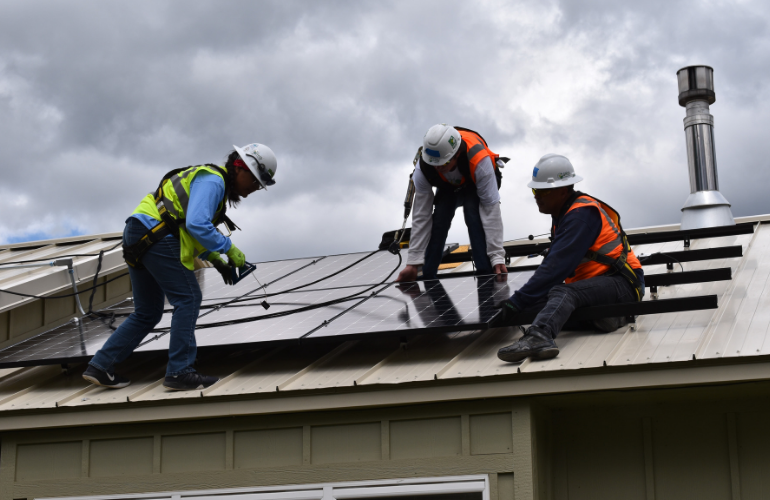 University of Oregon Tribal Climate Change Funding Guide The Tribal Climate Change Funding Guide is intended to provide up-to-date information on grants, programs and plans that may assist tribes in addressing climate change through a broad range of sectors.
University of Oregon Tribal Climate Change Funding Guide The Tribal Climate Change Funding Guide is intended to provide up-to-date information on grants, programs and plans that may assist tribes in addressing climate change through a broad range of sectors.- HUD Build for the Future Funding Navigator. The Funding Navigator provides a listing of funding opportunities under the Inflation Reduction Act (IRA), Bipartisan Infrastructure Law (BIL), and others across federal agencies to support efforts to enhance climate resiliency, energy efficiency, renewable energy integration, healthy housing, workforce development and environmental justice in HUD supported communities, programs and properties. Find open and upcoming opportunities, including funding status and where to apply, for funds to implement projects that reduce energy use and strengthen resiliency in communities.
- Indian Community Development Block Grant: The Indian Community Development Block Grant (ICDBG) Program provides eligible grantees with direct grants for use in developing Indian and Alaska Native communities, including the provision of decent housing, a suitable living environment, and economic opportunities, primarily for low- and moderate-income persons. The ICDBG provides single purpose grants which are awarded on a competition basis as well as imminent threat grants which are awarded first come, first served to lessen or eliminate problems which pose an imminent threat to the health and safety of Tribal residents.
- Indian Housing Block Grant: The Indian Housing Block Grant Program (IHBG) is a formula grant that provides a range of affordable housing activities on Indian reservations and Indian areas. The block grant approach to housing for Native Americans was enabled by the Native American Housing Assistance and Self Determination Act of 1996 (NAHASDA).
- Native Hawaiian Block Grant: The Native Hawaiian Housing Block Grant program provides funds to eligible affordable housing activities for low-income (not exceeding 80% of the median income for the area) native Hawaiians eligible to reside on Hawaiian home lands
- Title VI Loan Guarantee Program: Title VI allows Tribes/Tribally Designated Housing Entities to use IHBG funds to leverage additional funds to finance affordable housing activities, so that it can undertake larger projects and build at today’s costs. This leverage is created by pledging the need portion of the tribe’s annual IHBG grant and the project’s income as security to HUD in exchange for a Title VI loan guarantee. Eligible projects include constructing new housing and building infrastructure.
- BIA Tribal Climate Resilience Program Tribally-designed training and planning climate adaptation, resilience, ocean and coastal management efforts. Funding will aid Tribes and Tribal organizations in enhancing preparedness in response to climate change impacts in addition to other ocean and coastal planning.
- FEMA Building Resilient Infrastructure and Communities Building Resilient Infrastructure and Communities (BRIC) will support states, local communities, tribes and territories as they undertake hazard mitigation projects, reducing the risks they face from disasters and natural hazards. The BRIC program guiding principles are supporting communities through capability- and capacity-building; encouraging and enabling innovation; promoting partnerships; enabling large projects; maintaining flexibility; and providing consistency.
- FEMA Hazard Mitigation Grants FEMA's hazard mitigation assistance provides funding for eligible mitigation measures that reduce disaster losses.
- Bipartisan Infrastructure Law Tribal Playbook: This playbook identifies program and sources of funds specifically set aside for Tribal communities under the law. There are over $13 billion dollars in Tribal-specific programs or set asides for Tribes within existing programs under the law. It also provides a guide to Tribal eligibility fore other programs under the law and identifies specific benefits or flexibilities for Tribes and Tribal communities.
- Guidebook to the Inflation Reduction Act’s Clean Energy and Climate Investments in Indian Country: This guidebook provides an overview of the clean energy, climate mitigation and resilience, agriculture, and conservation-related funding programs in the Inflation Reduction Act for which Tribes are eligible. The guidebook also provides information on how Tribes can leverage new and expanded clean energy tax credits to reduce pollution and energy costs on Tribal lands. The law includes more than $720 million dollars in Tribal-specific programs or set-asides for Tribes within other programs. This guide identifies programs and sources of funds specifically allocated for Tribal communities. It also provides a guide to Tribal eligibility for other Inflation Reduction Act funding programs.
WEBINARS
- HUD/Treasury Webinar: Climate Resilience, Energy Efficiency, and Renewables (August 31, 2023)
Power Point, Recorded Webinar and Tribal Clean Energy Funding Opportunities - HUD/DOE Office of Indian Energy Webinar: Federal Incentives and Support for Tribal Housing Energy Projects (October 26, 2023)Power Point, Recorded Webinar, and DOE Tribal Home Electrification and Appliance Rebates
Follow the Office of Native American Programs on Twitter
Questions? Contact the ONAP Web manager.
